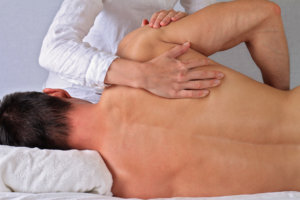Shoulder Pain Symptoms
Shoulder Impingement Syndrome is characterized by a dull aching pain in the front or outside of the shoulder that can radiate to the elbow. Sleeping can be painful and when you raise your arm it can become sharp. Shoulder impingement is a common sports injury. Our Manhattan chiropractors see this condition often—and it’s usually a repetitive stress injury related to occupations requiring prolonged static postures. Faulty joint mechanics cause compression on the tendons resulting in impingement syndrome. If you understand the mechanics of the shoulder, you can effectively treat and prevent this condition.
Mechanics of Shoulder Impingement Syndrome
The GH (glenohumeral) joint is a ball and socket where the glenoid fossa is the cup and the humerus is the ball. The stability of the joint is maintained by 4 muscles that comprise the rotator cuff (the SITS muscles).
- S-Supraspinatus-exerts downward pull
- I-Infraspinatus-exerts downward pull
- T-Teres minor-exerts downward pull
- S-Subscapularis -exerts inward pull
 The middle Delt is the primary mover for laterally raising the arm up from the side from 0-60 degrees. The middle delt raises the arm to the side but also pulls the humeral head (ball) superior and out of the glenoid fossa (cup). To keep this motion in check, three of the four rotator cuff muscles exert a downward pull on the humeral head, while the subscapularis is the only rotator cuff muscle to exert a inward pull on the humeral head.
The middle Delt is the primary mover for laterally raising the arm up from the side from 0-60 degrees. The middle delt raises the arm to the side but also pulls the humeral head (ball) superior and out of the glenoid fossa (cup). To keep this motion in check, three of the four rotator cuff muscles exert a downward pull on the humeral head, while the subscapularis is the only rotator cuff muscle to exert a inward pull on the humeral head.
The acromium is the top of your wing bone or scapula and makes up the roof of the shoulder joint and the suprahumeral space is the “tunnel” of the shoulder joint, which separates the roof of the shoulder from the ball of the arm bone. The supraspinatus and long head of the biceps pass through the suprahumeral space and are susceptible to compression forces.
Weakness of any of the rotator cuff muscles may lead to abnormal upward motion of the humeral head, decreasing the suprahumeral space and putting pressure on the long head of the bicep or supraspinatus tendon.
When the arm raises from 60 degrees to 140 degrees the upper trap, lower trap and serratus anterior muscles move the scapula and the roof (acromium process) upwards to maintain the tunnel or supraspinatus space. If the rotator cuff muscles have a deficiency it put the long head of the bicep and supraspinatus at at risk for injury and eventually leads to shoulder impingement. This syndrome can be caused by acute or overuse injury and may lead to degenerative changes if this shoulder condition is not addressed.
Chiropractic Treatment of Shoulder Pain at CSC+M in NYC
At CSC+M, our goal is to normalize the function through the integration of services utilizing chiropractic care, physical therapy, massage, acupuncture and medical services to restore balance to the upper extremity. Shoulder impingement always involves the subscapularis, be sure to avoid these common impingement patterns.
